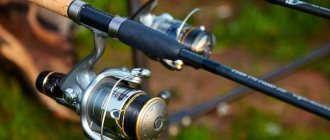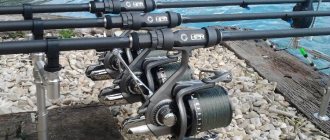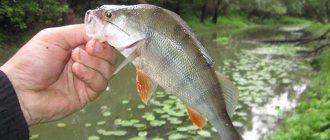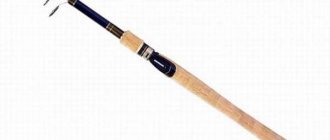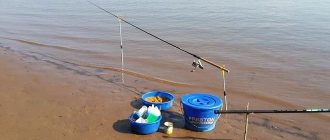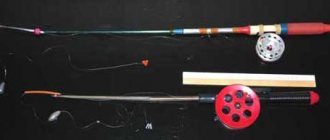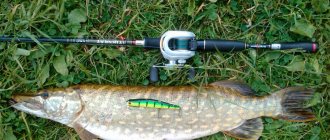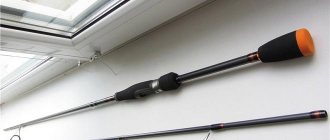Purpose of the spinning rod
The term “spinning”, applied to the fishing rod, as well as the name of the tackle of the same name, comes from the English word - spinning - “rotation”. A spinning rod is an integral part of sports gear, consisting of a rod, reel, fishing line (braided cord) and artificial bait. Let's consider the principle of operation of the gear that requires a spinning rod.
A fishing line wound on a reel, which in turn is attached to the fishing rod with a special device (reel seat), is threaded through the through-rings of the spinning rod. The end of the fishing line is connected to the artificial bait with a special knot or carabiner. Using a spinning rod, the bait is thrown into a body of water, usually inhabited by predatory representatives of aquatic fauna. By rotating the coil with a certain frequency and intensity, the bait is set in motion, imitating the natural inhabitant of the reservoir (fish, crayfish, insects, etc.), thereby provoking the predator to attack.
The reaction of a predator to the bait is determined by the behavior of the tackle; in some cases, when it comes to active fish, it is expressed by hitting the rod or twitching it. In the arsenal of an experienced spinning fisher, there is an impressive set of signs - “bites”, indicating a manifestation of interest in the bait, requiring a response and, very often, an immediate reaction on his part.
The conclusion suggests itself that a spinning rod, as part of the equipment, is used to cast and retrieve bait, detect bites, hook and reel in the fished object.
In spinning gear, there are no floats and probably are not expected, so it’s all a matter of feeling. If you felt it, you hooked it, didn’t notice the bite, and the fish spat out the bait and never mind. An unsuccessful choice of spinning rod at the initial stage of its development leads to the fact that many predator bites go unnoticed, and frequent unsuccessful fishing can cause disappointment and discourage the desire to engage in spinning fishing for a long time.
For this reason, when choosing a spinning rod, it is necessary to take into account the fact that in order to recognize the bite of predatory fish without float gear, the rod must be very sensitive. For this purpose, for each weight category of fish caught, from small (light) to very large (very heavy), a special rod class is used that meets the mandatory requirements, the main of which is the power of the rod. By “power” we mean the ability of a fishing rod to withstand certain loads caused by the fishing process and calculated for each class of spinning rod.
Spinning rod power class
The conventional classification of spinning rods implies four main classes: Light, Medium, Heavy, Extra-heavy; and three intermediate ones - Ultra-light, Medium-light, Medium-heavy, which are reflected in the table in the following order; the generally accepted name of the class is its English designation - an abbreviated designation in Latin letters.
- Ultra-light - Ultra Light - UL.
- Light - Light - L.
- Medium-light - Medium Light - ML.
- Medium - Medium - M.
- Medium-heavy - Medium Heavy - HM.
- Heavy - Heavy - HM.
- Extra heavy - Extra Heavy - HM.
If there is no information about the class of the rod on the rod, then you can get it using such a concept as the “bait weight test”, the marking of which is a mandatory attribute of a fishing rod of any production.
Fishing rod test based on bait weight
For each class of rod there is a limited range of lure weights recommended by the manufacturer for use with it, which is considered to be a rod test based on lure weight . The manufacturer's recommendations are based on accurate calculations and verification testing of tackle with baits of a certain weight, with which the rod shows the best performance and fully realizes its potential.
The tested lure weight range is indicated on the rod by two numbers separated by a hyphen, corresponding to the minimum and maximum weight of the recommended lures. It is with these baits, in this weight range, that the blank - the working part of the rod excluding the handle - retains the best characteristics.
On Asian-made spinning rods, which make up the bulk of mid-budget fishing rods, the following weight test designations are often found: “CW15-40g” or “15-40g” the letters “CW” are the first letters of the phrase “Casting Weight ” literally meaning “throwing weight 15-40g. » or “lure 4-18g” - “bait 4-18g” .
Some English-speaking manufacturers of spinning rods indicate the bait weight test in fractions of an ounce of avoirdupois , for example: “1/4-3/8 oz”. The weight of an ounce of avoirdupois is 28.35 g. It is easy to convert to grams by multiplying the values in fractions of an ounce by 28.35 g. and receiving a rounded test for the weight of the bait in grams “7.1-10.7g.” For those who have forgotten the rules for multiplying fractions, I remind you: for the test value 28.35g. multiply by 1 and divide by 4 we get - 7.0875g. — round up to 7.1g, to calculate the second test value we do the same.
If the weight of the bait used exceeds the value recommended by the manufacturer, there is a high probability of the rod breaking during a power cast. When using baits weighing less than the minimum test value, their flight range is significantly limited, for the reason that the throwing potential of the rod, designed for a larger weight of the bait, remains unrealized.
Correspondence of the test for the weight of the bait with the class of the spinning rod:
- Ultra - light - Ultra Light - UL - 1-7g.
- Light - Light - L - 3-14g.
- Medium - light - Medium Light - ML - 5-20g.
- Medium - Medium - M - 10-30g.
- Medium - heavy - Medium Heavy - MH - 15-40g.
- Heavy - Heavy - H - 20-50g.
- Extra - heavy - Extra Heavy - EH - from 60 and above.
If you decide to cast a bait weighing 2g with a “medium” class rod, it doesn’t matter, you simply won’t get it to the right place or the casting will not be accurate, but if you throw a weight of 30g with an “ultra-light” one, you can break the rod whip or at best, you won’t get an effective cast with an overloaded spinning rod. It is necessary to strictly observe the correspondence of the weight of the bait used with the test for its weight indicated on the fishing rod, especially regarding its maximum permissible values (upper limit).
The rod class designation is not found on all spinning rods, and the “weight test” is a mandatory form marking , by which you can always determine the rod class using the above correspondence. For example: the form indicates the test “20-50g”, which means this is a rod of the “heavy” class “Heavy”, abbreviated as “HM” . You can safely throw baits from 20 to 50 grams; for baits this is a significant weight and size, and therefore you are supposed to catch large fish with them (catfish, taimen, deep-sea pike, etc.).
Fishing for small fish with a powerful heavy-class spinning rod is a futile task. A powerful spinning rod is insensitive and the bite of small fish, in most cases, goes unnoticed. For small and medium fish (perch, trout, small chub, etc.) rods of the “light” and “ultra-light” class are suitable.
Highly sensitive spinning rods of the “Ultra Light” class with a test of 1-7g, designed for the use of miniature baits, which are almost impossible to cast with a rod of another class, while obtaining the maximum flight range. Rods of the “ultra-light” class are very thin and fragile and require careful and delicate handling. You can become the owner of this class of rod only after gaining some experience in handling “light” tackle.
To master spinning fishing and all its subtleties, such as; long-range and accurate casting of the bait, pendulum casting, the ability to throw the bait from any side of the body, competently and correctly selected wiring technique, beautiful and “gentle” hooking and much more, a “medium -light” class spinning rod with a “5-20g” test is suitable.
Such a rod can “forgive” a novice spinning angler some mistakes, without upsetting him with its breakdown.
There are situations when large fish bite on small and light baits, which are not easy to catch even for an experienced fisherman. This begs the question: “What to do in such a case? Shouldn’t you break the line?” A correctly selected fishing line, taking into account its breaking load and the power of the spinning rod, will break on its own. If the fishing line size is not chosen correctly, there may be several options.
The worst of them is if the friction brake of the reel is too tight, in this case, at the moment of hooking, the rod can break (most of the predators, when hooked, strongly resist, while making impressive jerks)
Due to the insufficient power of the spinning rod, you will have to loosen the clutch during fishing, thereby reducing the load on the rod; any inaccuracy in adjusting the friction brake (the direction of adjusting the brake was mixed up or it was not loosened enough) will cause the rod to break. An excessively weakened friction brake complicates the fishing of a predator, allowing it to tangle the fishing line, leading it into shelters (snag, reeds, etc.), and does not prevent the fish being caught from performing various maneuvers and pirouettes, with the help of which it very often gets off the hook.
Calculator Pounds to Grams
You convert pounds to grams
Calculator - Weight and Mass - Pounds to Grams
How many grams in pounds - convert pounds to grams
1 Pound (lb) = 453.5 Grams (g)
Pounds The pound or pound-mass (abbreviations: “lb”, “lbm”, “lbm”) is a unit of mass that has several definitions. Today, the most commonly used currency is the international avoirdupois pound, which is defined as 0.45359237 kilograms. A pound is equal to 16 ounces.
Grams A gram (symbol: “g”) is a metric unit of mass. One gram is equal to 1/1000 of a kilogram in SI or 1E3 kg. Today, the gram is a widely used unit of measurement for solids in food preparation and in grocery stores around the world.
Conversion of units of Weight and Mass
Convert from
Convert to
lb
=
G
| Basic units of weight | |
| Carat | car |
| Gram | gr |
| Kilogram | kg |
| Milligram | mg |
| Ounce | oz |
| Lb | lb |
| Ton | T |
| Other units of mass | |
| Assarion | assarion |
| Atomic mass unit (Dalton) | A. eat. |
| Attogram | ag |
| Bekah | |
| Centigram | cg |
| Dalton | |
| Dg | dg |
| Dekagram | dag |
| Denarius | denarius |
| Didrachm | didrachma |
| Drachma | drachma |
| Dina | dyn |
| Exagram | Eg |
| Femtogram | fg |
| Hera | gerah |
| Gigagram | Gg |
| Grain | gr |
| Hectogram | hg |
| Hundredweight | cwt |
| Hundredweight(UK) | cwt |
| Kip | |
| Mite | lepton |
| Megagram | Mg |
| Microgram | µg |
| Mine | mina |
| Mina(Biblical Hebrew) | mina |
| Nanogram | ng |
| Pennyweight | pwt |
| Petagram | Pg |
| Picagram | pg |
| Poundal | pdl |
| Quadrant | quadrans |
| Quarter | |
| Quarter(UK) | quarter |
| Quintal | quint. |
| Scruple | scr |
| Shekel | shekel |
| Slug | |
| Stone | st |
| Stone(UK) | st |
| Talent(Greek) | |
| Talent(Hebrew) | |
| Teragram | Tg |
| Tetradrachm | tetradrachma |
| Ton | |
| English ton | |
| Troy ounce | |
| Pharmacist's pound | |
| Basic units of weight | |
| Carat | car |
| Gram | gr |
| Kilogram | kg |
| Milligram | mg |
| Ounce | oz |
| Lb | lb |
| Ton | T |
| Other units of mass | |
| Assarion | assarion |
| Atomic mass unit (Dalton) | A. eat. |
| Attogram | ag |
| Bekah | |
| Centigram | cg |
| Dalton | |
| Dg | dg |
| Dekagram | dag |
| Denarius | denarius |
| Didrachm | didrachma |
| Drachma | drachma |
| Dina | dyn |
| Exagram | Eg |
| Femtogram | fg |
| Hera | gerah |
| Gigagram | Gg |
| Grain | gr |
| Hectogram | hg |
| Hundredweight | cwt |
| Hundredweight(UK) | cwt |
| Kip | |
| Mite | lepton |
| Megagram | Mg |
| Microgram | µg |
| Mine | mina |
| Mina(Biblical Hebrew) | mina |
| Nanogram | ng |
| Pennyweight | pwt |
| Petagram | Pg |
| Picagram | pg |
| Poundal | pdl |
| Quadrant | quadrans |
| Quarter | |
| Quarter(UK) | quarter |
| Quintal | quint. |
| Scruple | scr |
| Shekel | shekel |
| Slug | |
| Stone | st |
| Stone(UK) | st |
| Talent(Greek) | |
| Talent(Hebrew) | |
| Teragram | Tg |
| Tetradrachm | tetradrachma |
| Ton | |
| English ton | |
| Troy ounce | |
| Pharmacist's pound | |
Conversion result:
Other popular mass and weight calculators
- Carat to Gram
- Carat to Kilogram
- Carat to Milligram
- Carats to Ounces
- Carat to Pound
- Carats to Tons
- Gram to Carat
- Gram to Kilogram
- Gram to Milligram
- Gram to Ounce
- Gram to Pound
- Grams to Tons
- Kilogram to Carats
- Kilograms to Grams
- Kilogram to Milligram
- Kilograms to Ounces
- Kilogram to Pounds
- Kilogram to Tons
- Milligram to Carat
- Milligram to Gram
- Milligram to Kilogram
- Milligram to Ounce
- Milligrams to Pounds
- Milligrams to Tons
- Ounce to Carats
- Ounce to Gram
- Ounce to Kilogram
- Ounce to Milligram
- Ounce to Pound
- Ounce to Ton
- Pound to Carat
- Pound to Gram
- Pound to Kilogram
- Pound to Milligram
- Pound to Ounce
- Pound to Tons
- Ton to Grams
- Ton to Kilos
- Ton to Milligrams
- Ton to Ounces
- Ton to Pounds
similar groups
Line test
The following rule will help to avoid such situations: “With each class of fishing rod, you must use only that line whose maximum possible breaking load the rod can withstand.”
In English slang, this rule fits into the phrase: “line test” - “line test”, means a test for the breaking load of a fishing line or, for short, “line test”.
The line test confirms the fact that the rod has been tested with a line whose breaking load is indicated on the form, and the ability of the rod to withstand the load stated by the line test is guaranteed by the manufacturer. The line test is measured in libra or kilograms and is marked on the rod blank accordingly: “LB”-libra or “kg”-kilogram.
For example, consider the rod marking shown in the photo. “line 4-10LB” means that a line from 4Lb to 10Lb can be used with this spinning rod. One libra corresponds to 460 g - 0.46 kg , multiplying 0.460 kg by 10Lb, we get 4.6 kg. — the maximum permissible strength limit of the fishing line that can be used with this spinning rod. Line with a strength less than the lower limit - 4Lb - 1.84 kg is not recommended to be used, as it can break when casting baits allowed by the weight test.
The conclusion suggests itself: a rod with line test - Line 4-10Lb, can withstand a maximum load of 4.6 kg. and it should not be loaded any more, according to the manufacturer’s recommendations.
Make it a rule not to use a line higher than the permissible test if you want to preserve the rod. With a skillful approach, using the line declared by the manufacturer, you can catch fish 30-40% more than the maximum allowable weight, using a spinning reel with a well-adjusted friction brake.
Below is the correspondence between the breaking load of the fishing line and the rod test by bait weight, in the following order: general name of the rod class; abbreviated English designation of a fishing rod class; rod test value based on bait weight; the maximum diameter of the fishing line used is the maximum permissible strength limit of the fishing line.
- Ultra light - UL - 1-7g - 0.18 mm - no more than 2.5 kg.
- Lightweight - L - 3-14g - 0.20 mm - no more than 4.25 kg.
- Medium light - ML - 5-20g - 0.22 mm - no more than 5.0 kg.
- Medium - M - 10-30g - 0.25 mm - no more than 6.0 kg.
- Medium-heavy - MH - 15-40g - 0.30 mm - no more than 8.0 kg.
- Heavy - H - 20-50g - 0.40 mm - no more than 12.0 kg.
- Extra heavy - EH - 60-150g - 0.50 mm - no more than 20.0 kg.
When using a braided cord, it should be taken into account that its diameter will be smaller, and the maximum breaking load should correspond to the table value for mono fishing line recommended for the selected class of fishing rod. Many fishing line manufacturers indicate its breaking load on the reel.
For example, on a mono line, we see in the photo, there is a marking “6LB”. In the case of our example for a rod with the “line 4-10Lb” test, there is not even a need to convert libra into kilograms, since the test marking on the spinning rod and on the line spool is indicated in libra. The breaking strength of the "6Lb" line falls within the specified line test range, with another 4 lb (1.84 kg) remaining in reserve.
Joke:
In an art gallery, a man stands for a long time near one painting. Then he approaches the director and asks to give him the artist’s phone number. — Do you want to buy this painting? - No, I want to know where he painted this landscape. “It seems to me that there should be trout in this river.”
Spinning line test
After choosing the bait, you need to choose the appropriate fishing line for the spinning rod. If the weight is too heavy, the spinning rod will break. A fishing line that breaks before the tackle breaks can save it. Such a fishing line should not be very strong, but also not very thin, otherwise it will break from the weight of the bait itself during casting. It is necessary to choose the fishing line that the spinning rod can withstand at its maximum breaking load.
Spinning rods and fishing lines are pre-tested for strength and breaking capacity, respectively. The result of such experiments is entered into the rod characteristics form in the form of a line test, or, as the international meaning is accepted, “Line test”. The line test is indicated on the rod blank and is measured in pounds (lb) or kilograms (kg). One pound equals approximately 0.46 kg. It’s easy to find the test, just find the word “line” on the form and two numbers indicating the minimum and maximum load weight that the fishing line can withstand without breaking the rod.
For example, in the characteristics of a spinning rod there is a marking “line 8 – 17lb”. This means that fishing line from 8 to 17 pounds is suitable for this tackle. For convenience, we convert into kilograms: (8*0.46=3.7kg) and (17*0.46=7.8). This means that the line test is 3.7–7.8 kg.
The minimum value indicates that a line with a tensile strength of less than 3.7 kg is not recommended for use with this rod. If it is less, the line may break when casting. The upper value shows that using a fishing line with a tensile strength higher than 7.8 kg is not recommended because if the load is higher than this value, the fishing line will withstand, and the spinning rod may break. It is best to choose a line with an average tensile strength because the test is not always specified correctly.
How to increase your fish catch? ">
Over 7 years of active fishing, I have found dozens of ways to improve the bite. Here are the most effective ones:
- Bite activator . This pheromone additive attracts fish most strongly in cold and warm water. Discussion of the bite activator “Hungry Fish”.
- Increased gear sensitivity. Read the appropriate manuals for your specific type of gear.
- Pheromone -based lures .
